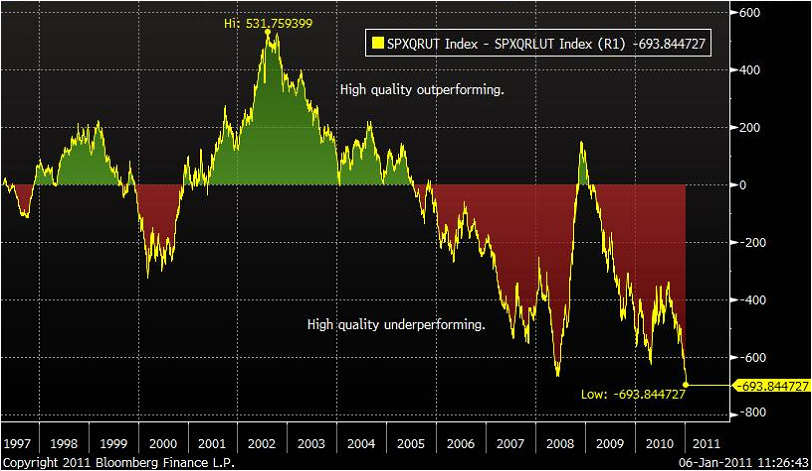In 2010 the U.S. stock market performed very well; however, the performance varied dramatically based on the riskiness of the stocks in a portfolio. Through the first eight months of 2010, the S&P 500 had a total return of -4.6%, while in the last four months of the year, the S&P 500 had a total return of +20.6%. In those final four months of the year, the small company Russell 2000 index had a spectacular total return of +30.7%. One of the common ways used to describe the swings in the market during the year was “risk on” and “risk off”. The “risk on” phrase conveys the concept that during these time periods the best returns were in the riskiest securities and the riskiest asset classes. So for example, during the first eight months of the year (risk off), bonds (low risk) outperformed small stocks (high risk) by almost 11%, while during the last four months (risk on) small stocks outperformed bonds by 32%! Similarly, the relative performance of large, high quality, dividend paying stocks was strong through August and weak for the remainder of the year.
With the huge upswing in risky stocks in the latter part of the year, high quality stocks have now under performed low quality stocks for most of the last ten years, with only relatively brief interruptions in 2001-02 and during the 2008 market collapse. This can be seen in the graph below. The line is rising when high quality stocks, as measured by the S&P quality rating, are doing well and falling when low quality stocks are doing well.

The persistently strong performance of small and risky companies has pushed these stocks to unusually expensive levels, making large and high quality companies unusually inexpensive by comparison. For example, small company stocks now sell at about a 20% premium valuation to large company stocks, equaling the highest relative valuation ever recorded, according to calculations by researchers at Credit Suisse Group. In a similar vein, the institutional investment firm, GMO, LLC, calculates that based on their current valuations, high quality stocks are likely to outperform small company stocks by more than 7% per year over the next seven years. While neither we nor GMO would expect to call the turning point in high quality stocks’ performance, this does give some sense of the long term opportunity that’s been created in the type of company our stock selection approach favors.